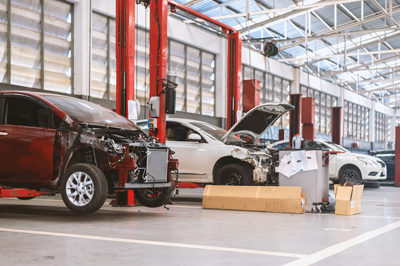Miles driven and average cost of repair are both on the rise, but more in line with pre-pandemic increases.
CCC Intelligent Solutions offered a look at industry stats and trends as of mid-year during a recent webinar hosted by the Collision Industry Electronic Commerce Association (CIECA).
Bart Mazurek, vice president of consulting services for CCC, said vehicle miles traveled through the first five months of this year, according to the U.S. Department of Transportation, was running a bit ahead of 2022.
“When we compare it to [pre-pandemic] 2019, it's actually fairly similar except for the April timeframe,” Mazurek said, which means there’s been “a noticeable bump compared to last year.”
More miles driven generally means some increase in vehicle accidents. And claims this year are, perhaps not surprisingly, involving a continued increase in the total cost of repairs. DRP claims in the first quarter of this year averaged $4,444, up $223 from the average for all of 2022.
But that 5.3% increase is more in line with the increases seen in 2019 and 2020, and significantly smaller than the jumps in total cost of repairs in 2021 (10.6%) and 2022 (14.3%).
While the increase should be good news for shops, the breakdown of those total costs may mean fewer dollars on the bottom line for collision repairers. In 2019 and 2020, according to CCC data, labor accounted for as much as 40.4% of total repair costs. That’s dropped by about two percentage points in 2022 and the first quarter of 2023, as parts and other costs---which generally have lower profit margins for shops---have increased as a percentage of the total costs of repairs.
Types of Parts Used Has Shifted
The breakdown of those parts costs by parts type---new OEM, non-aftermarket, salvage---also has shifted, according to data reported by CCC. In 2020, non-OEM parts accounted for 18.4% of the total dollars, but that fell to as low as 15.6% in the first quarter of 2022.
“That was because most aftermarket parts come from Asia, and supply chain issues certainly took effect,” Mazurek said. “So there was limited availability of aftermarket parts.”
But that began rebounding in the second quarter of last year, reaching 19.2% in the first quarter of this year, “really right back to its historical norms,” Mazurek said.
He said he expects total cost of repairs to push closer to $5,000 in this half of 2023. That’s because repairs of newer vehicles are requiring more parts---about 16 per claim compared to about 12 for vehicles seven years or older.
“It’s much more part intensive because today’s vehicles have so much more technology that either works [after an accident] or it doesn’t, so it’s not necessarily repairable and needs to be replaced,” Mazurek said.
Claims on vehicles up to 3 years old are already averaging more than $5,000 compared to about $3,600 for the oldest vehicles repaired. About 37% of DRP claims last year were $4,000 or higher, up from just 26% in 2019. And the percentage of claims over $10,000 doubled from 4% to 8% between 2019 and 2022.
More Scans, Calibrations
In other trends CCC is seeing, the percentage of direct repair claims that include one or more scans has jumped 14% since the start of 2022. About 73% of those claims this year have included a scan, up from 63% in the first quarter of 2022.
Scanning fees on those claims in the first quarter of this year averaged $137 per claim---the national average including DRP and non-DRP claims was $141---with an average of 2.3 scanning line items per claim. Fees for calibrations averaged $401 and 1.4 line items for DRP claims in the first quarter of this year, with calibrations being listed on 16% of claims, up from 10% in the first quarter of 2022.
Looking at DRP claims involving current model year vehicles, the recent change is even more dramatic.
“It's really gone from 20% [of those claims] to 35% effectively in just in the last five or six quarters,” CCC’s Mazurek said. “I anticipate that as even more vehicles have ADAS capabilities built in, there's going to be the need for additional calibrations, and multiple calibrations will just become that much more common across the industry.”
Labor rates have continued to increase, particularly for mechanical labor. CCC data show mechanical rates rising 11% in 2022, and 8.6% through the first half of 2023. Those are larger percentage increases than the year-over-year change in that period in rates for body and frame labor, which were generally in the 6% to 9% range.
Turning to electric vehicle trends, Mazurek said about 295,000 new electric vehicles were purchased in the second quarter of this year, signaling the annual pace of EV sales will top the forecast for not just this year but next year as well.
“It’s really outpaced everyone’s expectations,” he said. “So my expectation is that by the time we actually get to 2024, we will be significantly north of the [forecast] 1.2 million vehicle [annual sales] mark.”
CCC data shows the average total cost of repairs for EVs in 2023 is running 38% higher when compared to non-EVs, with an average of 34.7 labor hours per appraisal, compared to 27.7 for non-EVs, and an average of 24.7 parts replaced, 10 more than non-EV claims.














John Yoswick